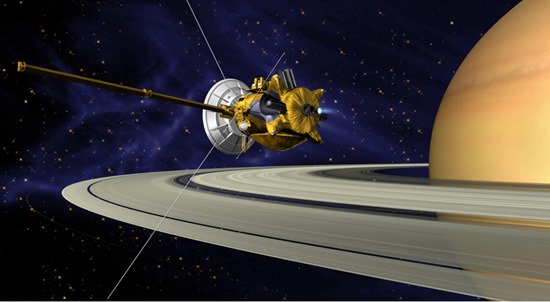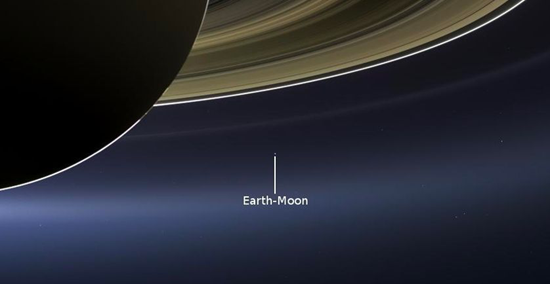
7 stunning discoveries about Saturn from the Cassini mission
By Michael d'Estries, Mother Nature Network, 8 December 2016.
By Michael d'Estries, Mother Nature Network, 8 December 2016.
After two decades in space, the Cassini spacecraft will end its mission on Sept. 15, 2017, with a fiery death plunge into Saturn's atmosphere. The dramatic event will mark the end of one of the most successful space expeditions in NASA's history.
"Major Cassini mission achievements are legion," planetary scientist Carolyn Porco, head of imaging science for the Cassini spacecraft, said in an interview.
"Technologically, it's the most daring and elaborate orbital tour of a planetary system yet executed, with vastly more flybys of planetary bodies, and the closest ever conducted, than any other mission we've ever flown. In fact, it may very well be that Cassini has conducted more close flyby manoeuvres - over 100 - than have ever been conducted in the entire planetary program."
While Cassini could technically continue to monitor Saturn for many years to come, the spacecraft is running low on rocket fuel. If it were to run out, scientists would no longer be able to control its orbit. Left unchecked, there's a real possibility the spacecraft could collide with one of two moons around Saturn thought to possibly contain life. To prevent contamination by any hardy Earth-borne microbes that may be lurking on Cassini, NASA is saying goodbye in dramatic fashion.
"It’s inspiring, adventurous and romantic - a fitting end to this thrilling story of discovery," NASA writes.
Below are just a few of the incredible discoveries Cassini has made over the course of its mission.
1. The landing of the Huygens probe on Titan
On Dec. 25, 2004, a four foot wide atmospheric entry probe named Huygens separated from Cassini and began its 22-day journey to the surface of Titan. The largest of Saturn's 62 moons, Titan is the only celestial body in space besides Earth that features stable bodies of surface liquid. When Huygens landed on January 14, 2005, it discovered a world similar to the early days of Earth before life evolved. Drainage channels, lakes, erosions, dunes, rainstorms, all appear to constantly shape and impact Titan's surface. The major difference is that much of the liquid is composed of methane and ethane, not to mention a frigid surface temperature recorded by Huygens of -290.83 °F.
In addition to its surface liquid, later flybys of Cassini have also detected the presence of a subsurface ocean likely as salty as Earth's own Dead Sea.
"This is an extremely salty ocean by Earth standards," Giuseppe Mitri of the University of Nantes in France told NASA. "Knowing this may change the way we view this ocean as a possible abode for present-day life, but conditions might have been very different there in the past."
2. A unparalleled close-up of Jupiter
Photo: NASA
During its nearly seven-year interplanetary journey to Saturn, Cassini had an opportunity to perform flybys of Earth, Venus and Jupiter. The latter was particularly spectacular, producing the most detailed true color photos of the gas giant ever recorded.
"Everything visible on the planet is a cloud," NASA explained in a blog post. "The parallel reddish-brown and white bands, the white ovals, and the large Great Red Spot persist over many years despite the intense turbulence visible in the atmosphere. These clouds grow and disappear over a few days and generate lightning. Streaks form as clouds are sheared apart by Jupiter's intense jet streams that run parallel to the colored bands."
3. Uncovering Saturn’s hidden moons
During its orbit around Saturn, Cassini has managed to pick out seven previously unknown moons in orbit within the planet's rings. These include Methone, Pallene, Polydeuces, Daphnis [pictured above], Anthe and Aegaeon. The seventh moon, discovered in 2009, is presently named S/2009 S 1 and is only 984 feet in diameter.
4. The subterranean habitable zone of Enceladus
Photo: NASA/JPL-Caltech
Saturn's icy moon of Enceladus may be hiding a subterranean ocean filled with extraterrestrial life. Frequent Cassini flybys of the moon, which measures roughly 310 miles in diameter, have found conditions favorable for microbes.
"It has liquid water, organic carbon, nitrogen [in the form of ammonia], and an energy source," Chris McKay, an astrobiologist at NASA's Ames Research Center in Moffett Field, California, told Daily Galaxy. "Besides Earth, there is no other environment in the solar system where we can make all those claims."
Before Cassini arrived at Enceladus, scientists long puzzled over why the moon boasted the brightest world in the solar system. Upon taking a closer look, they were stunned to see massive geysers, akin to ice volcanoes, spewing liquid water to create a smooth, frozen white surface. Enceladus, it turns out, is an active moon with a global ocean of warm liquid salty water beneath its crust.
“As we continue to learn more about Enceladus, and compare data from different instruments, we are finding more and more evidence for a habitable ocean world,” Linda Spilker, Cassini Project Scientist, told NASA. “If life is eventually discovered in Enceladus’ ocean by a mission after Cassini, then our Enceladus discoveries will have been among the top discoveries for all planetary missions.”
5. Saturn's giant hurricane
Photo: NASA/JPL-Caltech/SSI
In 2006, scientists studying Cassini's images of Saturn were baffled to discover what appeared to be a massive hurricane churning away at its north pole. The find was remarkable because, outside of Earth, the weather phenomenon had never been observed on another planet before.
As you might expect, this is no ordinary hurricane. Not only is it 50 times the size of an average hurricane on Earth (its eye alone is 1,250 miles wide) with winds four times as fast, but it is also completely stationary. The other mystifying feature is how it formed in the first place without access to large quantities of water vapor.
"We did a double take when we saw this vortex because it looks so much like a hurricane on Earth," said Andrew Ingersoll, a Cassini imaging team member at the California Institute of Technology in Pasadena, said in a release. "But there it is at Saturn, on a much larger scale, and it is somehow getting by on the small amounts of water vapor in Saturn's hydrogen atmosphere."
6. 'The Day the Earth Smiled'
Photo: NASA/JPL-Caltech/SSI
One of the most celebrated space photos in recent memory occurred on July 19, 2013. On that date, Cassini positioned itself in the shadow of Saturn and turned its camera back towards its host. Besides capturing beautiful new details on the ringed planet and its moons, the spacecraft also managed to spy our own pale blue dot in the bottom left. The picture, so-named "The Day the Earth Smiled," was unique because it marked the first time that humanity was given advanced notice that a picture of Earth would be taken from deep space.
Planetary scientist Carolyn Porco helped to organize the event, telling people to go outside "look up, think about our cosmic place, think about our planet, how unusual it is, how lush and life-giving it is, think about your own existence, think about the magnitude of the accomplishment that this picture-taking session entails. We have a spacecraft at Saturn. We are truly interplanetary explorers. Think about all that, and smile."
Photo: NASA/JPL-Caltech/SSI
The photo above, stitched together from 141 wide-angle images shot over four hours, spans a total distance of 404,880 miles. It also marks only the third time our home has been photographed from the outer solar system.
7. A new view from the top
At the end of November, Cassini began the first of 20 orbital maneuvers designed to position the spacecraft for its final death plunge on September 17, 2017. Each of these orbits will take the Cassini high above and far below the planet. NASA recently received images from the spacecraft sitting just above Saturn's turbulent northern hemisphere. While not in color, they show incredible detail of the hurricane that continues to spin and rage at the north pole.
"This is it, the beginning of the end of our historic exploration of Saturn. Let these images - and those to come - remind you that we’ve lived a bold and daring adventure around the solar system’s most magnificent planet," said Carolyn Porco.
As Cassini edges closer and closer to its subject, NASA will receive back unprecedented details of the planet. During its final plunge, it will record valuable information about Saturn's hydrogen atmosphere until its signal is lost.
Related on Mother Nature Network:
Top image: An artist's render of Cassini in orbit around Saturn. The spacecraft measures 22 ft. long by 13 ft. wide and weighs roughly 12,000 pounds. Credit: NASA/JPL.








No comments:
Post a Comment
Please adhere to proper blog etiquette when posting your comments. This blog owner will exercise his absolution discretion in allowing or rejecting any comments that are deemed seditious, defamatory, libelous, racist, vulgar, insulting, and other remarks that exhibit similar characteristics. If you insist on using anonymous comments, please write your name or other IDs at the end of your message.